TOYOTA HIGHLANDER 2015 XU50 / 3.G Owners Manual
Manufacturer: TOYOTA, Model Year: 2015, Model line: HIGHLANDER, Model: TOYOTA HIGHLANDER 2015 XU50 / 3.GPages: 712, PDF Size: 10.59 MB
Page 211 of 712
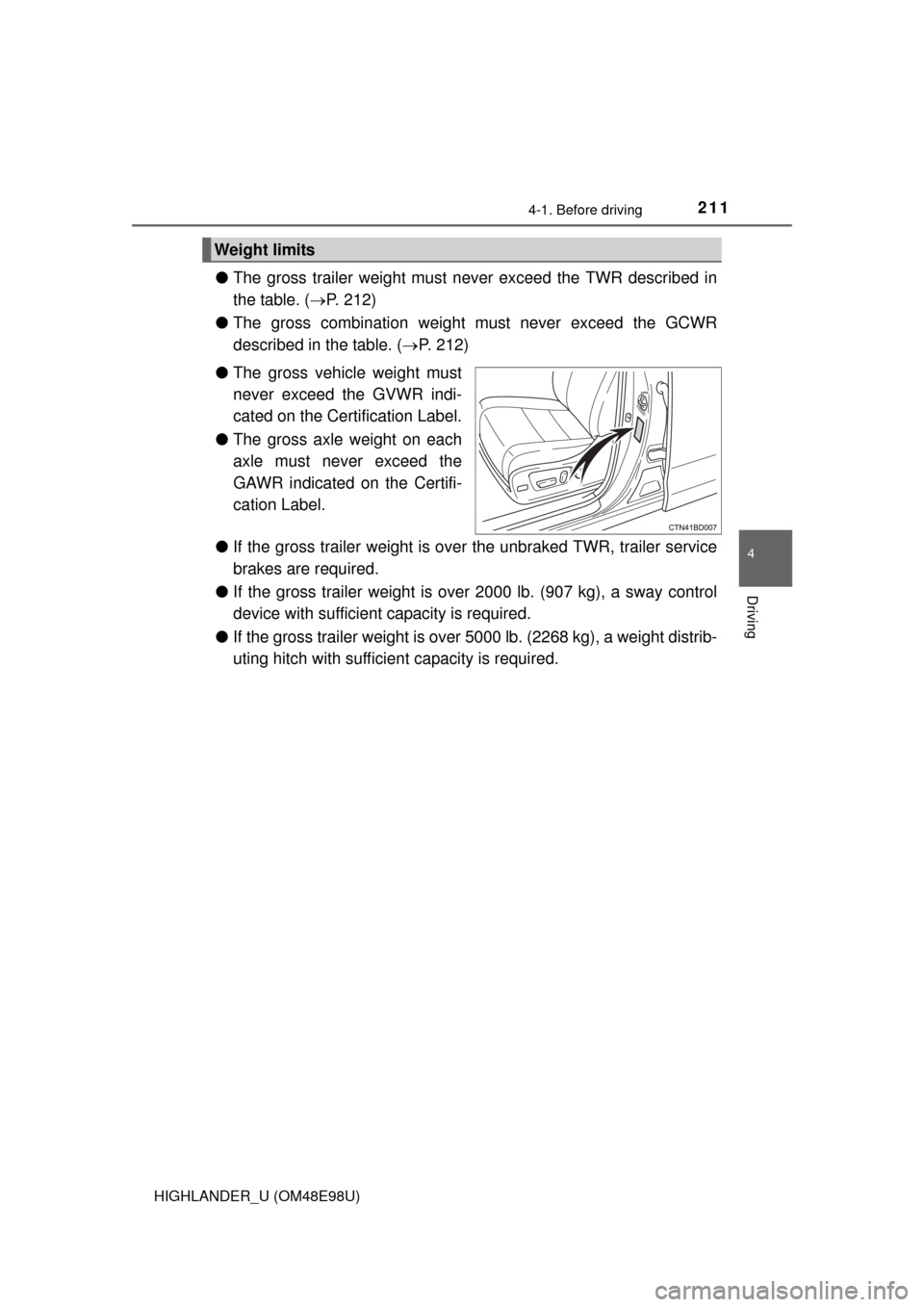
2114-1. Before driving
4
Driving
HIGHLANDER_U (OM48E98U)
●The gross trailer weight must never exceed the TWR described in
the table. ( P. 212)
● The gross combination weight must never exceed the GCWR
described in the table. ( P. 212)
● The gross vehicle weight must
never exceed the GVWR indi-
cated on the Certification Label.
● The gross axle weight on each
axle must never exceed the
GAWR indicated on the Certifi-
cation Label.
● If the gross trailer weight is over the unbraked TWR, trailer service
brakes are required.
● If the gross trailer weight is over 2000 lb. (907 kg), a sway control
device with sufficient capacity is required.
● If the gross trailer weight is over 5000 lb. (2268 kg), a weight distrib-
uting hitch with sufficient capacity is required.
Weight limits
Page 212 of 712
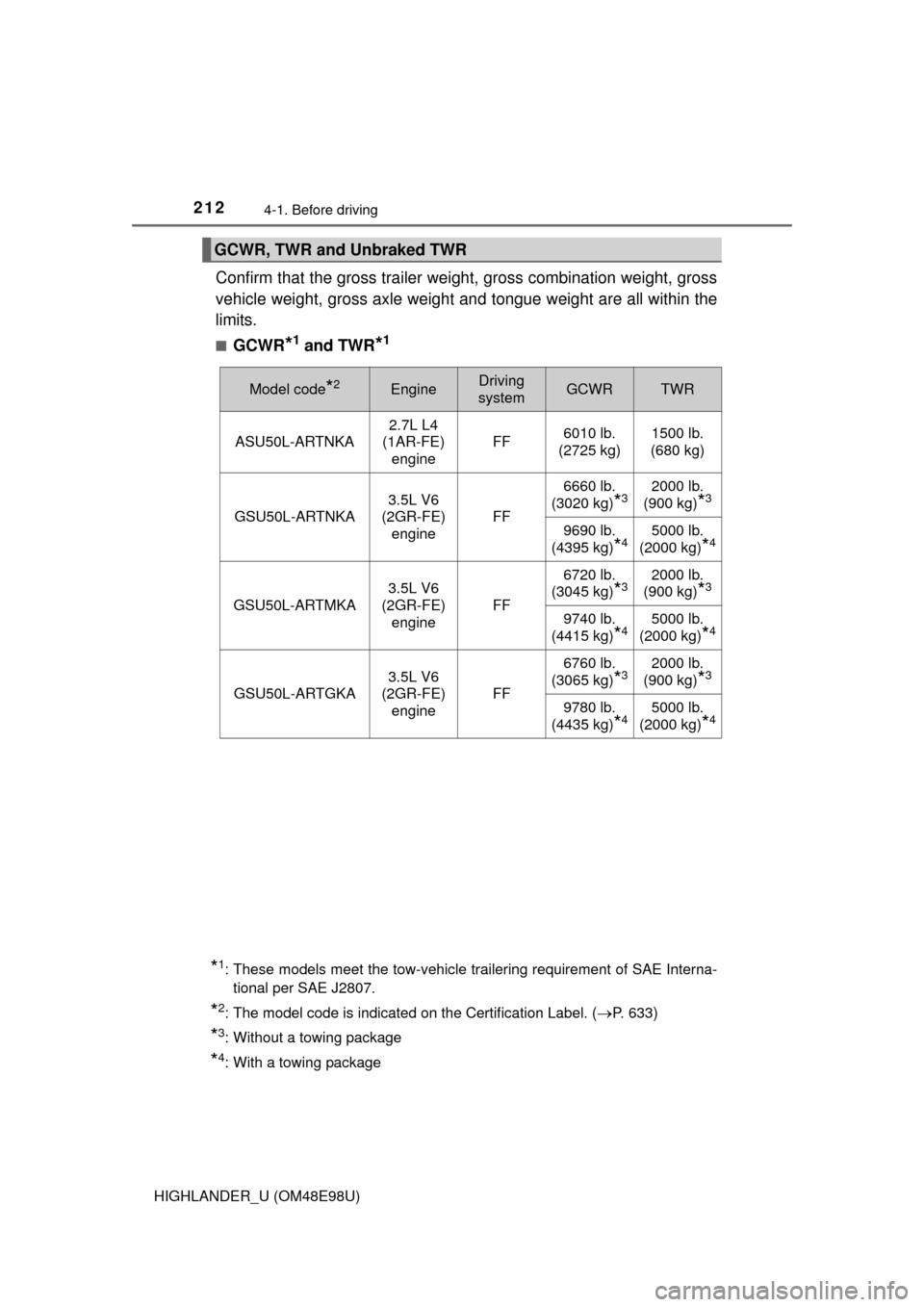
2124-1. Before driving
HIGHLANDER_U (OM48E98U)
Confirm that the gross trailer weight, gross combination weight, gross
vehicle weight, gross axle weight and tongue weight are all within the
limits.
■GCWR*1 and TWR*1
GCWR, TWR and Unbraked TWR
*1: These models meet the tow-vehicle trailering requirement of SAE Interna-tional per SAE J2807.
*2: The model code is indicated on the Certification Label. (P. 633)
*3: Without a towing package
*4: With a towing package
Model code*2EngineDriving
systemGCWRTWR
ASU50L-ARTNKA
2.7L L4
(1AR-FE) engine
FF6010 lb.
(2725 kg)1500 lb.
(680 kg)
GSU50L-ARTNKA
3.5L V6
(2GR-FE)
engine
FF
6660 lb.
(3020 kg)
*32000 lb.
(900 kg)
*3
9690 lb.
(4395 kg)
*45000 lb.
(2000 kg)
*4
GSU50L-ARTMKA
3.5L V6
(2GR-FE)
engine
FF
6720 lb.
(3045 kg)
*32000 lb.
(900 kg)
*3
9740 lb.
(4415 kg)
*45000 lb.
(2000 kg)
*4
GSU50L-ARTGKA
3.5L V6
(2GR-FE)
engine
FF
6760 lb.
(3065 kg)
*32000 lb.
(900 kg)
*3
9780 lb.
(4435 kg)
*45000 lb.
(2000 kg)
*4
Page 213 of 712
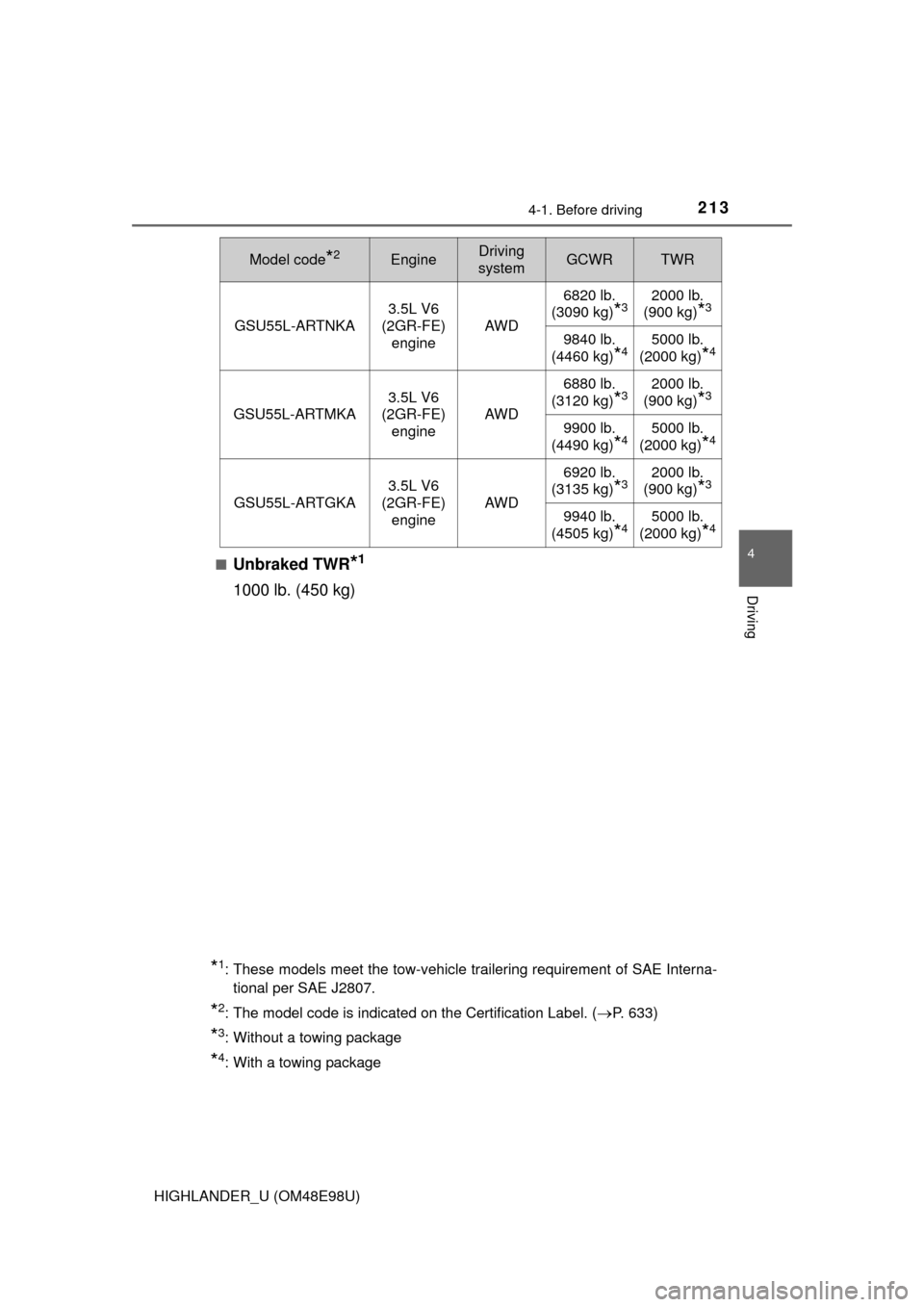
2134-1. Before driving
4
Driving
HIGHLANDER_U (OM48E98U)■
Unbraked TWR*1
1000 lb. (450 kg)
GSU55L-ARTNKA
3.5L V6
(2GR-FE)
engine
AWD
6820 lb.
(3090 kg)
*32000 lb.
(900 kg)
*3
9840 lb.
(4460 kg)
*45000 lb.
(2000 kg)
*4
GSU55L-ARTMKA
3.5L V6
(2GR-FE)
engine
AWD
6880 lb.
(3120 kg)
*32000 lb.
(900 kg)
*3
9900 lb.
(4490 kg)
*45000 lb.
(2000 kg)
*4
GSU55L-ARTGKA
3.5L V6
(2GR-FE)
engine
AWD
6920 lb.
(3135 kg)
*32000 lb.
(900 kg)
*3
9940 lb.
(4505 kg)
*45000 lb.
(2000 kg)
*4
*1: These models meet the tow-vehicle trailering requirement of SAE Interna-
tional per SAE J2807.
*2: The model code is indicated on the Certification Label. (P. 633)
*3: Without a towing package
*4: With a towing package
Model code*2EngineDriving
systemGCWRTWR
Page 214 of 712
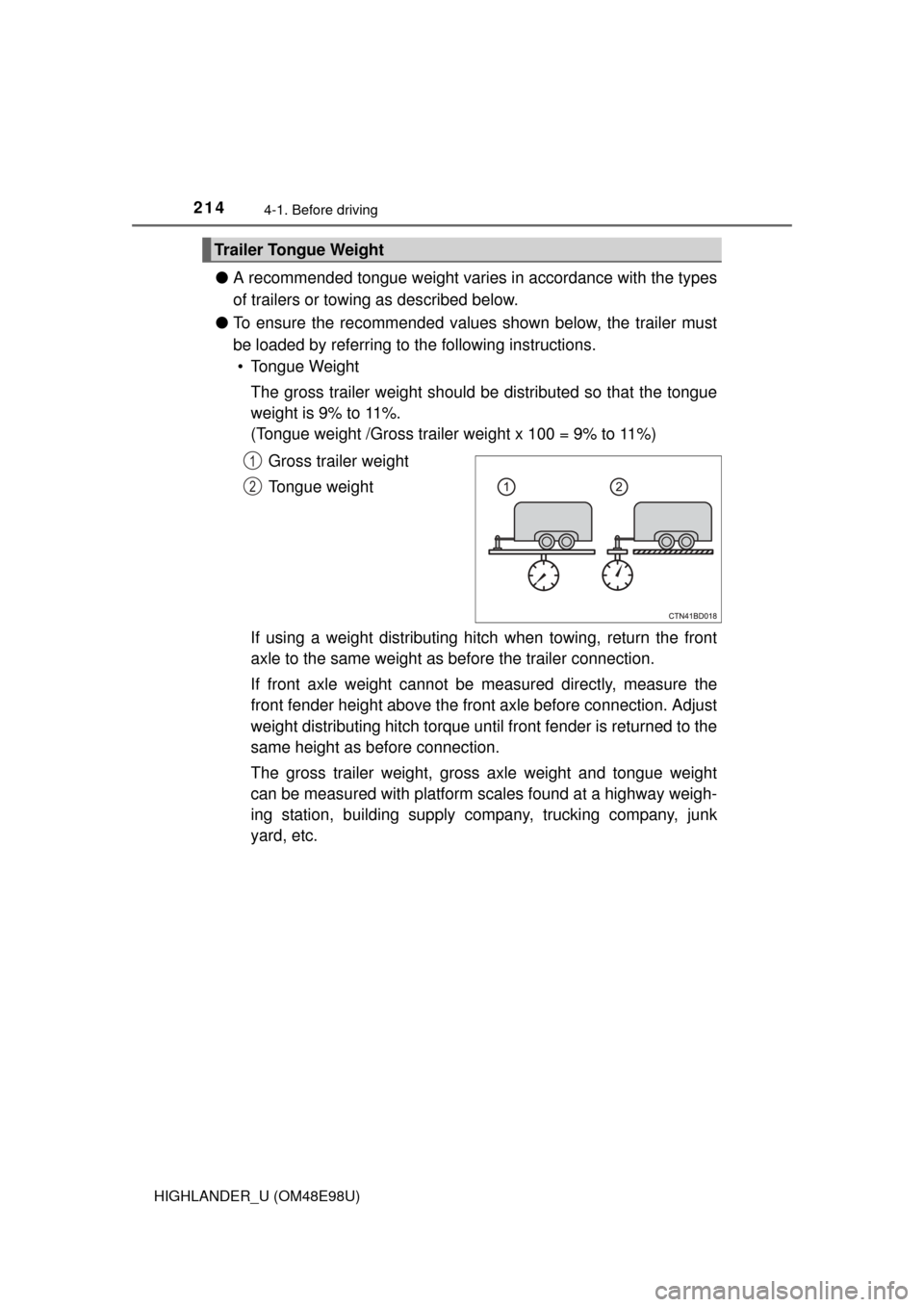
2144-1. Before driving
HIGHLANDER_U (OM48E98U)
●A recommended tongue weight varies in accordance with the types
of trailers or towing as described below.
● To ensure the recommended values shown below, the trailer must
be loaded by referring to the following instructions.
• Tongue Weight
The gross trailer weight should be distributed so that the tongue
weight is 9% to 11%.
(Tongue weight /Gross trailer weight x 100 = 9% to 11%)
Gross trailer weight
Tongue weight
If using a weight distributing hitch when towing, return the front
axle to the same weight as before the trailer connection.
If front axle weight cannot be measured directly, measure the
front fender height above the front axle before connection. Adjust
weight distributing hitch torque until front fender is returned to the
same height as before connection.
The gross trailer weight, gross axle weight and tongue weight
can be measured with platform scales found at a highway weigh-
ing station, building supply company, trucking company, junk
yard, etc.
Trailer Tongue Weight
1
2
Page 215 of 712
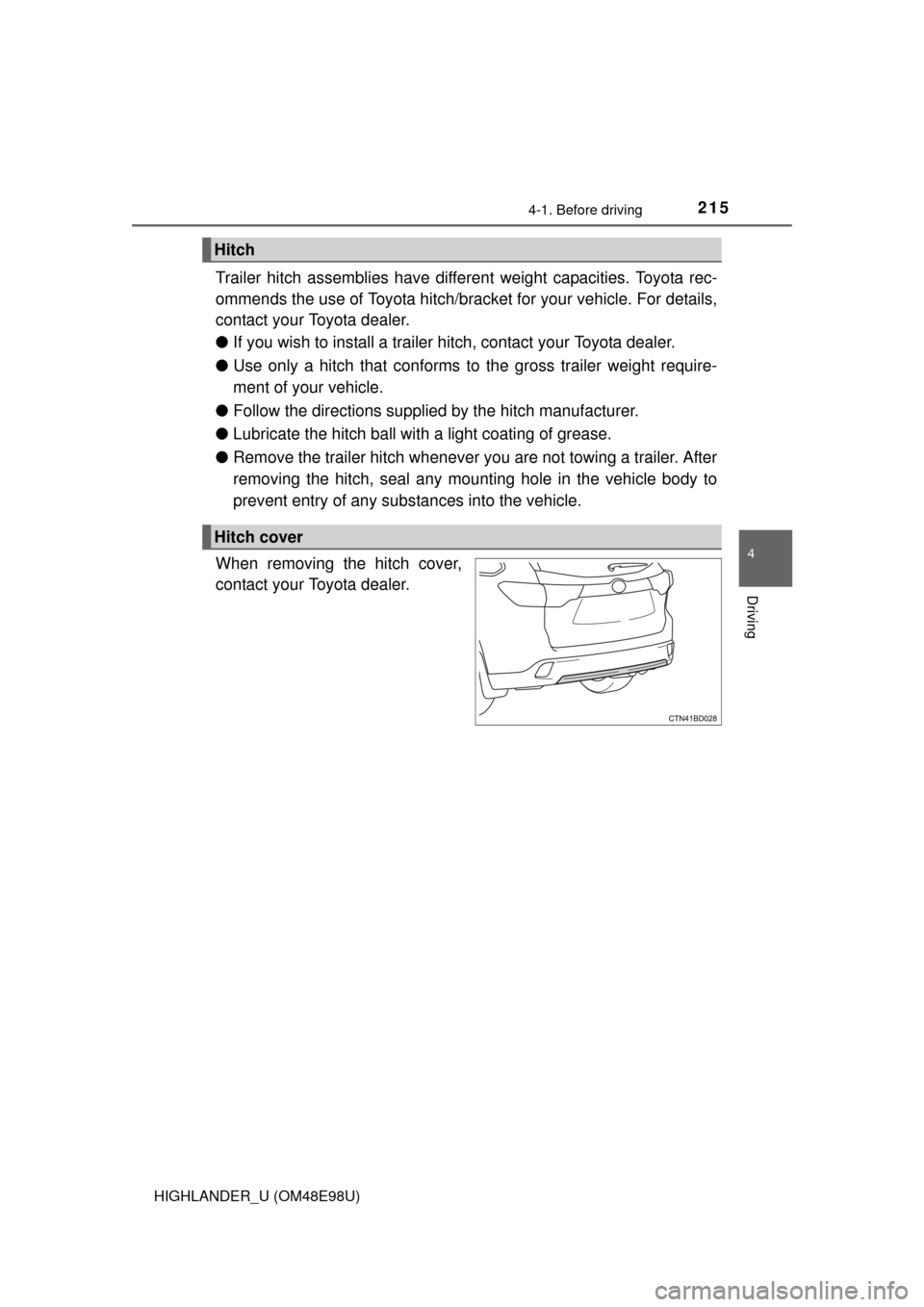
2154-1. Before driving
4
Driving
HIGHLANDER_U (OM48E98U)
Trailer hitch assemblies have different weight capacities. Toyota rec-
ommends the use of Toyota hitch/bracket for your vehicle. For details,
contact your Toyota dealer.
●If you wish to install a trailer hitch, contact your Toyota dealer.
● Use only a hitch that conforms to the gross trailer weight require-
ment of your vehicle.
● Follow the directions supplied by the hitch manufacturer.
● Lubricate the hitch ball with a light coating of grease.
● Remove the trailer hitch whenever you are not towing a trailer. After
removing the hitch, seal any mounting hole in the vehicle body to
prevent entry of any subs tances into the vehicle.
When removing the hitch cover,
contact your Toyota dealer.
Hitch
Hitch cover
Page 216 of 712
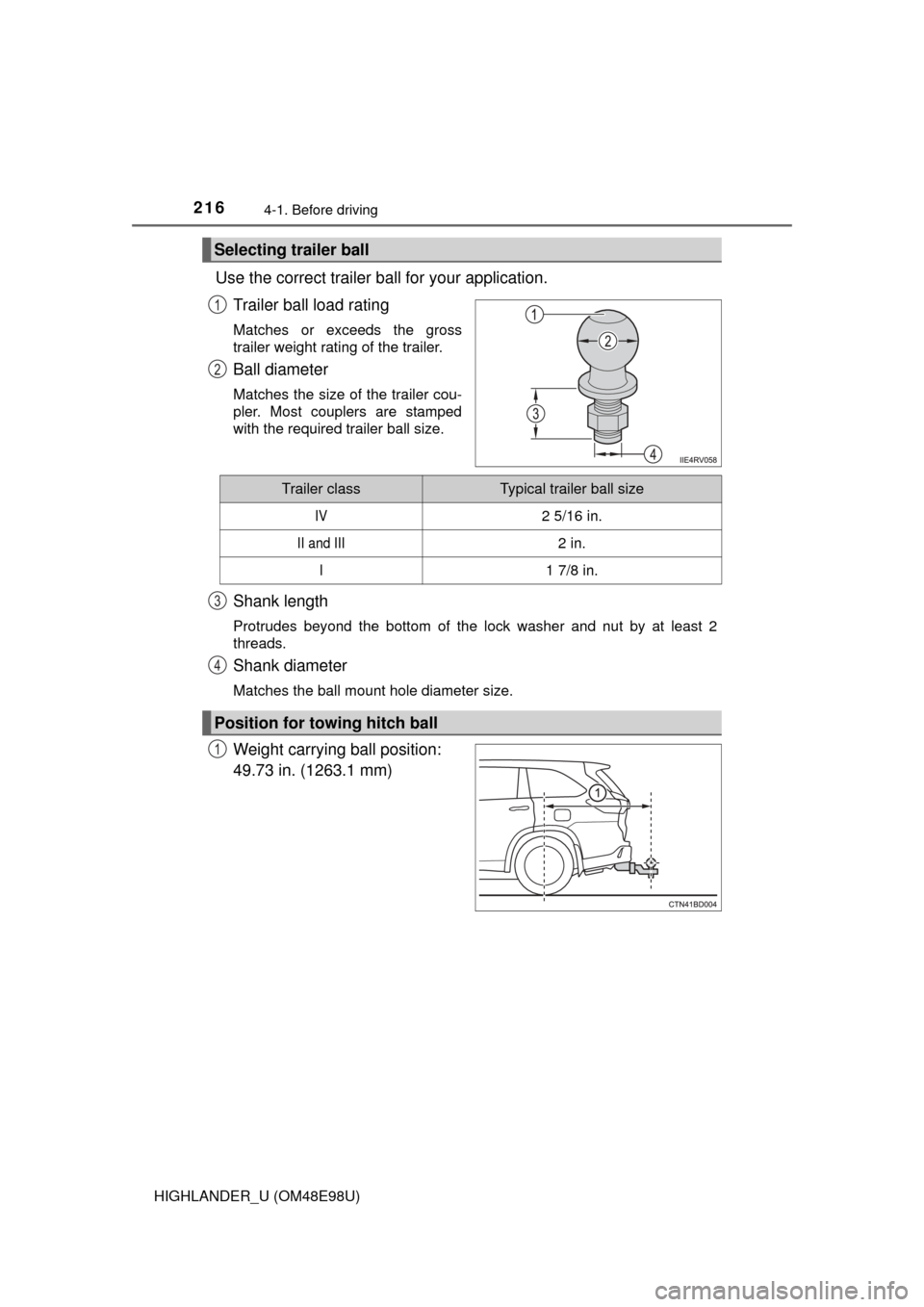
2164-1. Before driving
HIGHLANDER_U (OM48E98U)
Use the correct trailer ball for your application.Trailer ball load rating
Matches or exceeds the gross
trailer weight rating of the trailer.
Ball diameter
Matches the size of the trailer cou-
pler. Most couplers are stamped
with the required trailer ball size.
Shank length
Protrudes beyond the bottom of the lock washer and nut by at least 2
threads.
Shank diameter
Matches the ball mount hole diameter size.
Weight carrying ball position:
49.73 in. (1263.1 mm)
Selecting trailer ball
1
2
Trailer classTypical trailer ball size
IV2 5/16 in.
II and III2 in.
I1 7/8 in.
Position for towing hitch ball
3
4
1
Page 217 of 712
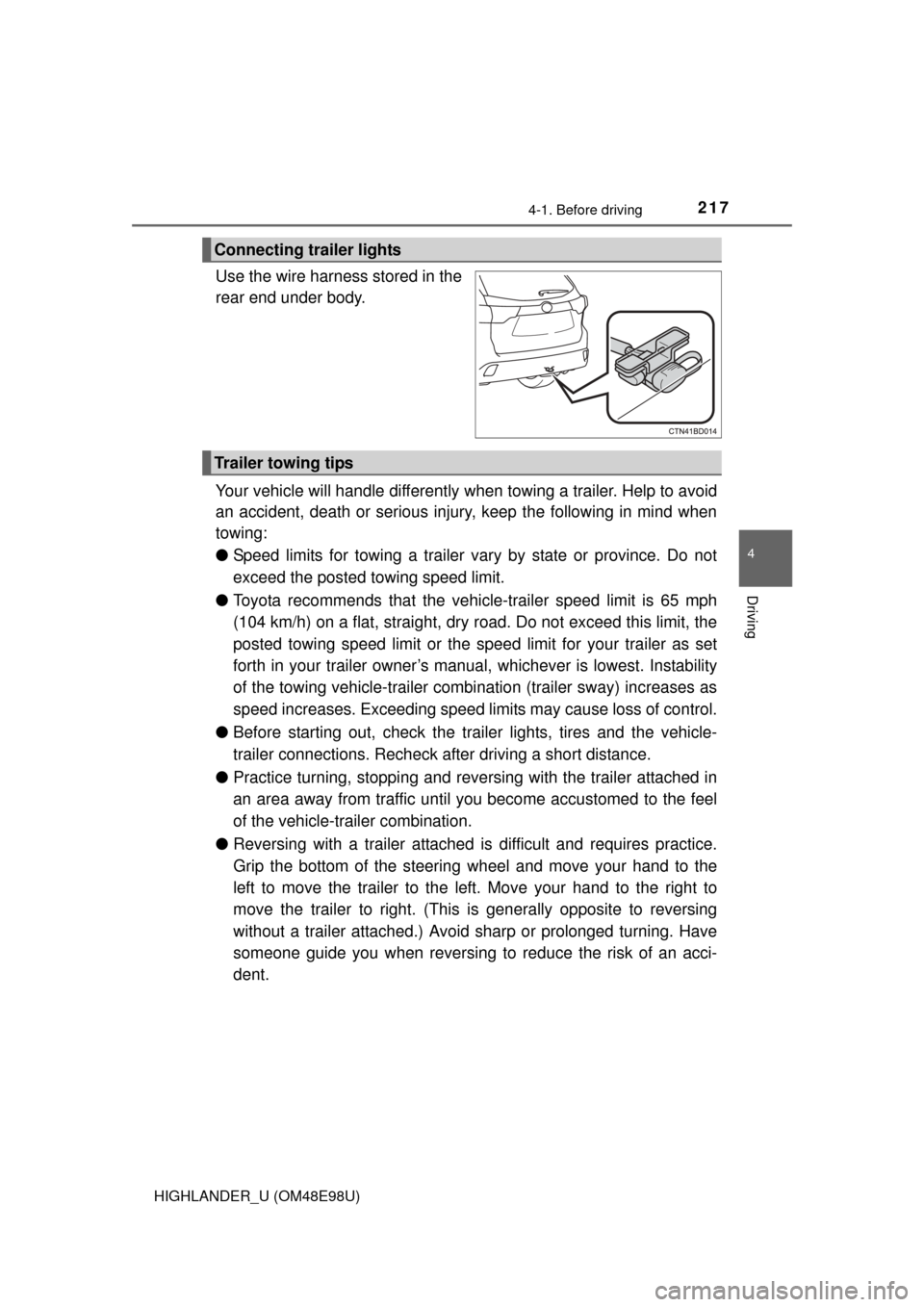
2174-1. Before driving
4
Driving
HIGHLANDER_U (OM48E98U)
Use the wire harness stored in the
rear end under body.
Your vehicle will handle differently when towing a trailer. Help to avoid
an accident, death or serious injury, keep the following in mind when
towing:
● Speed limits for towing a trailer vary by state or province. Do not
exceed the posted to wing speed limit.
● Toyota recommends that the vehicle-trailer speed limit is 65 mph
(104 km/h) on a flat, straight, dry road. Do not exceed this limit, the
posted towing speed limit or the spe ed limit for your trailer as set
forth in your trailer owner’s manual, whichever is lowest. Instability
of the towing vehicle-trailer combination (trailer sway) increases as
speed increases. Exceeding speed limits may cause loss of control.
● Before starting out, check the trailer lights, tires and the vehicle-
trailer connections. Recheck after driving a short distance.
● Practice turning, stopping and reve rsing with the trailer attached in
an area away from traffic until you become accustomed to the feel
of the vehicle-trailer combination.
● Reversing with a trailer attached is difficult and requires practice.
Grip the bottom of the steering wheel and move your hand to the
left to move the traile r to the left. Move your hand to the right to
move the trailer to right. (This is generally opposite to reversing
without a trailer attached.) Avoid sharp or prolonged turning. Have
someone guide you when reversing to reduce the risk of an acci-
dent.
Connecting trailer lights
Trailer towing tips
Page 218 of 712

2184-1. Before driving
HIGHLANDER_U (OM48E98U)
●As stopping distance is increased when towing a trailer, vehicle-to
vehicle distance should be increa sed. For each 10 mph (16 km/h)
of speed, allow at least one vehicle and trailer length.
● Avoid sudden braking as you may skid, resulting in the trailer jack-
knifing and a loss of vehicle contro l. This is especially true on wet or
slippery surfaces.
● Avoid jerky starts or sudden acceleration.
● Avoid jerky steering and sharp turns, and slow down before making
turn.
● Note that when making a turn, the trailer wheels will be closer than
the vehicle wheels to the inside of the turn. Compensate by making
a wider than normal turning radius.
● Slow down before making a turn, in cross winds, on wet or slippery
surfaces, etc.
Increasing vehicle speed can destabilize the trailer.
● Take care when passing other vehicles. Passing requires consider-
able distance. After passing a vehicle, do not forget the length of
your trailer, and be sure you hav e plenty of room before changing
lanes.
● To maintain engine braking effici ency and charging system perfor-
mance when using engine braking, do not put the transmission in
D. If in the S mode, the transmission shift range position must be in
4 or lower.
● Instability happens more frequently when descending steep or long
downhill grades. Before descending, slow down and downshift. Do
not make sudden downshifts while descending steep or long down-
hill grades.
● Avoid holding the brake pedal down too long or applying the brakes
too frequently. This could cause th e brakes to overheat and result in
reduced braking efficiency.
Page 219 of 712
![TOYOTA HIGHLANDER 2015 XU50 / 3.G Owners Manual 2194-1. Before driving
4
Driving
HIGHLANDER_U (OM48E98U)
●Due to the added load of the trailer, your vehicle’s engine may over-
heat on hot days (at temperatures over 85 F [30C]) when drivin TOYOTA HIGHLANDER 2015 XU50 / 3.G Owners Manual 2194-1. Before driving
4
Driving
HIGHLANDER_U (OM48E98U)
●Due to the added load of the trailer, your vehicle’s engine may over-
heat on hot days (at temperatures over 85 F [30C]) when drivin](/img/14/6421/w960_6421-218.png)
2194-1. Before driving
4
Driving
HIGHLANDER_U (OM48E98U)
●Due to the added load of the trailer, your vehicle’s engine may over-
heat on hot days (at temperatures over 85 F [30C]) when driving
up a long or steep grade. If t he engine coolant temperature gauge
indicates overheating, immediately turn off the air conditioning (if in
use), pull your vehicle off the road and stop in a safe spot.
( P. 626)
● Always place wheel blocks under both the vehicle’s and the trailer’s
wheels when parking. Apply the pa rking brake firmly, and put the
transmission in P. Avoid parking on a slope, but if unavoidable, do
so only after performing the following:
Apply the brakes and keep them applied.
Have someone place wheel blocks under both the vehicle’s and
trailer’s wheels.
When the wheel blocks are in pl ace, release the brakes slowly
until the blocks absorb the load.
Apply the parking brake firmly.
Shift into P and turn off the engine.
● When restarting after parking on a slope:
With the transmission in P, start the engine. Be sure to keep the
brake pedal depressed.
Shift into a forward gear. If reversing, shift into R.
Release the parking brake and brake pedal, and slowly pull or
back away from the wheel blocks. Stop and apply the brakes.
Have someone retrieve the blocks.
1
2
3
4
5
1
2
3
4
Page 220 of 712
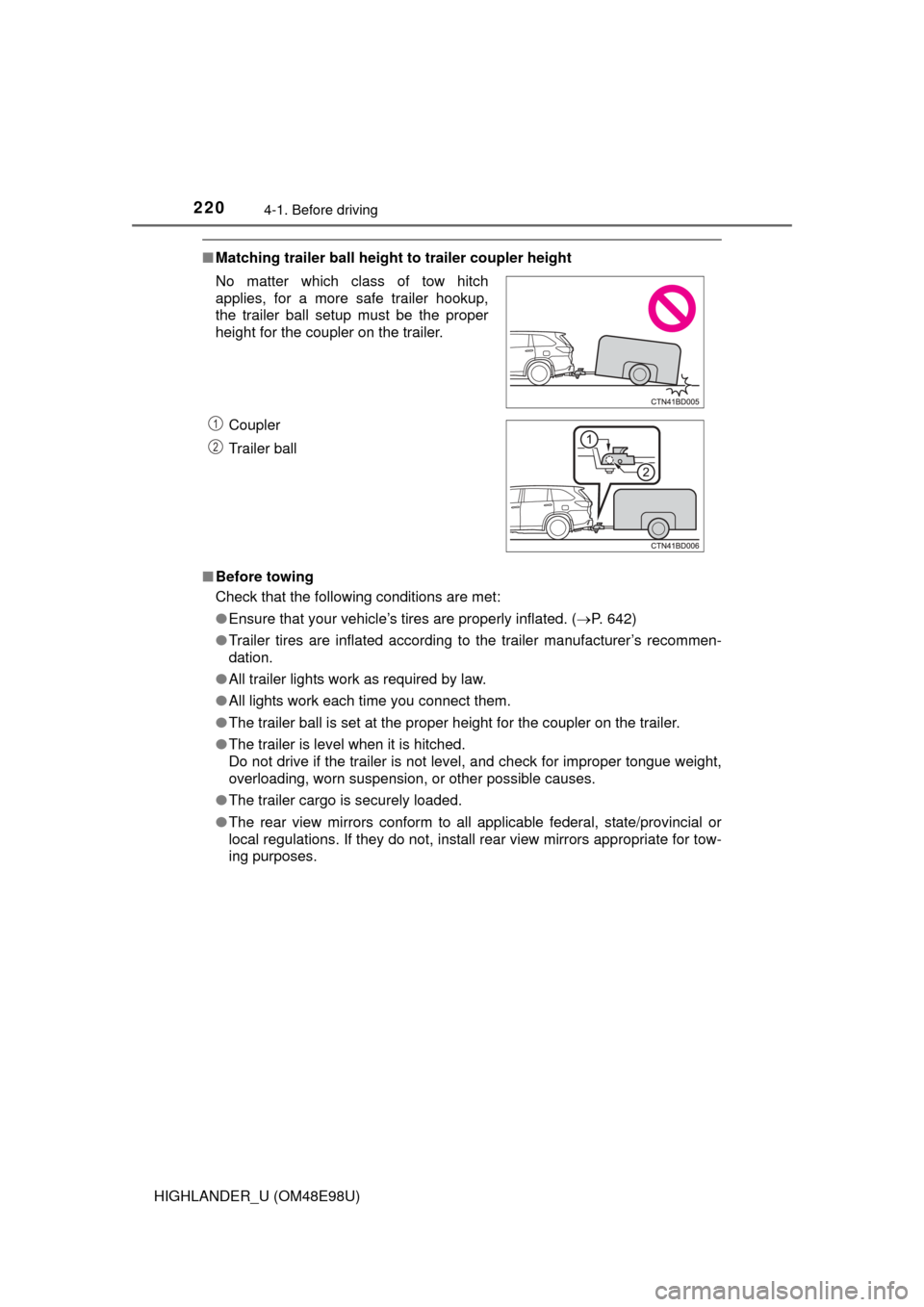
2204-1. Before driving
HIGHLANDER_U (OM48E98U)
■Matching trailer ball height to trailer coupler height
■ Before towing
Check that the following conditions are met:
●Ensure that your vehicle’s tires are properly inflated. ( P. 642)
● Trailer tires are inflated according to the trailer manufacturer’s recommen-
dation.
● All trailer lights work as required by law.
● All lights work each time you connect them.
● The trailer ball is set at the proper height for the coupler on the trailer.
● The trailer is level when it is hitched.
Do not drive if the trailer is not level, and check for improper tongue weight,
overloading, worn suspension, or other possible causes.
● The trailer cargo is securely loaded.
● The rear view mirrors conform to all applicable federal, state/provincial or
local regulations. If they do not, install rear view mirrors appropriate for tow-
ing purposes.
No matter which class of tow hitch
applies, for a more safe trailer hookup,
the trailer ball setup must be the proper
height for the coupler on the trailer.
Coupler
Trailer ball
1
2